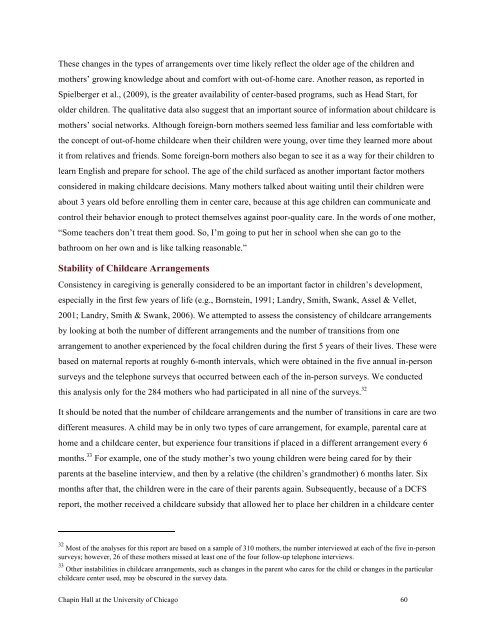2011 The Palm Beach County Family Study (Full Report)
2011 The Palm Beach County Family Study (Full Report)
2011 The Palm Beach County Family Study (Full Report)
- No tags were found...
Create successful ePaper yourself
Turn your PDF publications into a flip-book with our unique Google optimized e-Paper software.
<strong>The</strong>se changes in the types of arrangements over time likely reflect the older age of the children andmothers’ growing knowledge about and comfort with out-of-home care. Another reason, as reported inSpielberger et al., (2009), is the greater availability of center-based programs, such as Head Start, forolder children. <strong>The</strong> qualitative data also suggest that an important source of information about childcare ismothers’ social networks. Although foreign-born mothers seemed less familiar and less comfortable withthe concept of out-of-home childcare when their children were young, over time they learned more aboutit from relatives and friends. Some foreign-born mothers also began to see it as a way for their children tolearn English and prepare for school. <strong>The</strong> age of the child surfaced as another important factor mothersconsidered in making childcare decisions. Many mothers talked about waiting until their children wereabout 3 years old before enrolling them in center care, because at this age children can communicate andcontrol their behavior enough to protect themselves against poor-quality care. In the words of one mother,“Some teachers don’t treat them good. So, I’m going to put her in school when she can go to thebathroom on her own and is like talking reasonable.”Stability of Childcare ArrangementsConsistency in caregiving is generally considered to be an important factor in children’s development,especially in the first few years of life (e.g., Bornstein, 1991; Landry, Smith, Swank, Assel & Vellet,2001; Landry, Smith & Swank, 2006). We attempted to assess the consistency of childcare arrangementsby looking at both the number of different arrangements and the number of transitions from onearrangement to another experienced by the focal children during the first 5 years of their lives. <strong>The</strong>se werebased on maternal reports at roughly 6-month intervals, which were obtained in the five annual in-personsurveys and the telephone surveys that occurred between each of the in-person surveys. We conductedthis analysis only for the 284 mothers who had participated in all nine of the surveys. 32It should be noted that the number of childcare arrangements and the number of transitions in care are twodifferent measures. A child may be in only two types of care arrangement, for example, parental care athome and a childcare center, but experience four transitions if placed in a different arrangement every 6months. 33 For example, one of the study mother’s two young children were being cared for by theirparents at the baseline interview, and then by a relative (the children’s grandmother) 6 months later. Sixmonths after that, the children were in the care of their parents again. Subsequently, because of a DCFSreport, the mother received a childcare subsidy that allowed her to place her children in a childcare center32 Most of the analyses for this report are based on a sample of 310 mothers, the number interviewed at each of the five in-personsurveys; however, 26 of these mothers missed at least one of the four follow-up telephone interviews.33 Other instabilities in childcare arrangements, such as changes in the parent who cares for the child or changes in the particularchildcare center used, may be obscured in the survey data.Chapin Hall at the University of Chicago 60
















